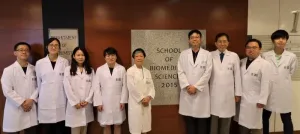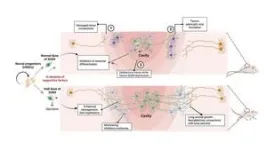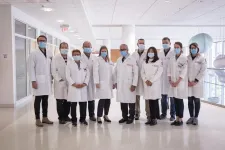(Press-News.org) A joint research team from LKS Faculty of Medicine, the University of Hong Kong (HKUMed) and City University of Hong Kong (CityU) has generated human neural stem cells with powerful therapeutic potential for the treatment of spinal cord injury that paves the way for new therapeutic opportunities. The new findings are now published in the leading multidisciplinary science journal, Advanced Science [link to publication].
Background
Traumatic spinal cord injury (SCI) commonly caused by a car accident, fall, or sport-related accident results in the progressive loss of neurons involved in motor and sensory functions at and around the site of injury. Consequently, SCI patients suffer from either permanent paralysis or varying degrees of impairment and loss of sensation depending on the severity of the injury. Currently, there are no effective treatments for SCI. The limited locomotor and sensory recovery after SCI has been attributed to the formation of glial scar around the site of injury that form the barrier-like structure to prevent neuronal regeneration. In addition, spinal neurons around the scar cannot be restored due to the low intrinsic regenerative ability of undamaged neurons and the lack of neural stem cells (NSCs) in the adult spinal cord.
Transplantation of human NSCs (hNSCs) derived from human pluripotent stem cells at the SCI sites has been considered a promising therapeutic strategy to compensate for the loss of spinal neurons and enable their connectivity with host neurons for spinal cord recovery. However, the injury environment favours astrocytes instead of neuronal formation which has limited the therapeutic efficacy of grafted hNSCs. Hence, most transplantation therapies adopt the use of a cocktail of growth factors embedded in the extracellular matrix to enhance the viability and neurogenic potency of grafted hNSCs in SCI rodent models, yet this approach takes a long time for hNSCs to mature and support functional recovery. This underlies an urgent need to remodel NSC grafts that can overcome both extrinsic and intrinsic barriers as an effective treatment for traumatic SCI.
Research methods and findings
The research team found that the graded reduction of Sex determining region Y-box transcription factor SOX9 gene expression in hNSCs is highly associated with the acquisition of neuronal lineage toward motor neuron fate. Consistently, the reduction of SOX9 expression by approximately 50% in hNSCs promotes motor neuron formation. Further reduction of SOX9 expression levels results in compromised cell survival and renewal. These findings indicate a dose-dependent role of SOX9 in regulating the initiation of neuronal formation, self-renewal, and survival of hNSCs. The enhanced neurogenic potency of hNSCs expressing 50% of SOX9 protein is partly attributed to decreased glucose consumption. These neurogenic and metabolic properties are retained in the SOX9-reduced hNSCs upon transplantation at the site of contusive SCI in rats without the need for growth-factor enriched matrics, suggesting that the injury environment did not affect their metabolic state and neuronal differentiation potential.
Importantly, SOX9 KD grafts exhibit excellent integration properties, predominantly differentiate into motor neurons, reduce glial scar matrix accumulation to facilitate long-distance axon growth and neuronal connectivity with the host as well as dramatically improve walking capacity and temperature sensation in recipient animals. Altogether, the research findings demonstrate that hNSCs with reduced SOX9 expression by half could overcome the post-injury environment and intrinsic limitations with enhanced therapeutic potential in the SCI rodent model. To enable the clinical translational of our findings, future efforts should focus on developing genetic strategies to reduce the level of SOX9 activity or expression in hNSCs by ~ 50% for transplantation treatment of SCI patients.
Significance of the study
‘Our work reveals a new paradigm in activating the intrinsic programme by using a genetically targeted strategy to enhance the therapeutic potential of hNSCs for treating SCI. This approach alters the grafts’ response in the injury environment and confers enhanced neuronal differentiation capacity, survival, and integration, as well as reduced glial scar formation to provide a more effective stem cell therapy for severe traumatic SCI,’ said Dr Martin Cheung Chi-hang, Associate Professor, School of Biomedical Sciences, HKUMed, also the lead researcher of the study.
About the research team
The research was led by Dr Martin Cheung Chi-hang, Associate Professor of the School of Biomedical Sciences, HKUMed; Dr Jessica Liu Aijia, Assistant Professor in the Department of Neuroscience, CityU; Professor Chan Ying-shing, Dexter H C Man Family Professor in Medical Science, Professor of the School of Biomedical Sciences, Director of Campus Development and Infrastructure, HKUMed, and Director of the Neuroscience Research Centre, HKU. Other members of the research team include Dr Tam Kin-wai, Chen Yong-long, Feng Xianglan, Christy Chan Wing-lam, Amos Lo Lok-hang, Dr Kenneth Wu Lap-kei, Hui Man-ning, Wu Ming-hoi, Dr Ken Chan Kwok-keung, and May Cheung Pui-lai. Other collaborators include Professor Cheung Chi-wai from the Department of Anaesthesiology, School of Clinical Medicine, HKUMed and Professor Daisy Shum Kwok-yan from School of Biomedical Sciences, HKUMed.
Acknowledgements
The work was supported by the General Research Fund of the Hong Kong Research Grants Council (No. 17123016, and No. 17110715).
Media enquiries
Please contact LKS Faculty of Medicine of The University of Hong Kong by email (medmedia@hku.hk).
END
HKUMed & CityU researchers jointly generate human neural stem cells with powerful therapeutic potential for the treatment of spinal cord injury, paving the way for new therapeutic opportunities
2023-08-17
ELSE PRESS RELEASES FROM THIS DATE:
Nauseous territory: outfoxing predators using baits that make them barf
2023-08-17
Introduced foxes, dogs, cats, rats, and other predators kill millions of native animals every year, but what if they were conditioned to associate this prey with food that made them ill?
A team of international researchers have shown the potential to do just that, burying baits containing capsules of levamisole, a chemical that induces nausea and vomiting when consumed by predators.
In a world first experiment conducted in south-eastern Australia, where introduced red foxes are responsible for countless wildlife deaths, the Australian National University (ANU) and University of South Australia scientists laid baits of fried deboned chicken, with some containing ...
Accelerating discovery in artificial intelligence for science
2023-08-17
What if artificial intelligence (AI) could be used to spur discovery in areas such as biotechnology, drug discovery and fluid dynamics? Using geometric graphs and innovative methodologies, AI can solve fundamental problems in basic natural science. The possibilities are endless in this relatively new field known as AI for science.
Dr. Shuiwang Ji, a professor in the Department of Computer Science and Engineering at Texas A&M University, recently received a National Science Foundation grant to ...
Sylvester Surgeon-scientist awarded center’s first Department of Defense grant to study pancreatic cancer
2023-08-17
MIAMI, FLORIDA (Aug. 17, 2023) – Researchers with Sylvester Comprehensive Cancer Center at the University of Miami Miller School of Medicine have been awarded a grant from the U.S. Department of Defense (DoD)’s Congressionally Directed Medical Research Program to target chemotherapy resistance in pancreatic cancer.
The $800,000, three-year grant is the first DoD award to Sylvester to study pancreatic cancer, a disease characterized by extreme resistance to chemotherapy and other treatments and dismal survival rates.
Pancreatic ductal adenocarcinoma is the most common and aggressive ...
Novel treatment based on gene editing safely and effectively removes HIV-like virus from genomes of non-human primates
2023-08-17
(Philadelphia, PA) – A single injection of a novel CRISPR gene-editing treatment safely and efficiently removes SIV – a virus related to the AIDS-causing agent HIV – from the genomes of non-human primates, scientists at the Lewis Katz School of Medicine at Temple University now report. The groundbreaking work complements previous experiments as the basis for the first-ever clinical trial of an HIV gene-editing technology in human patients, which was authorized by the Food and Drug Administration (FDA) in 2022.
The preclinical study, published online ...
Urban great tits have paler plumage than their forest-living relatives
2023-08-17
As urban areas expand, animals increasingly find themselves living in towns and cities. While some animals may benefit from milder temperatures and fewer natural predators in urban settings, they also have to cope with pollutants and changes in their diet. Previous research has shown that animals in cities are “duller” in terms of yellow-orange-red colour tones compared to their non-urban counterparts. However, previous studies have only focused on single geographic locations.
“We used feather samples collected from great tits in cities and forests across Europe. Different methods all confirmed that urban great tits ...
Our plastic waste can be used as raw material for detergents, thanks to an improved catalytic method
2023-08-17
(Santa Barbara, Calif.) — We’ve managed to accumulate so much plastic trash that it’s daunting to think about what could be done with the tons upon tons of nonbiodegradable waste. And as much as we are trying to scale back our dependence on single-use plastics, we continue to add to the global plastic trash hoard. Events like the COVID-19 pandemic only served to expand their use for personal protective equipment and disposable and take-away packaging.
But, for researchers at UC Santa Barbara, one person’s single-use packaging ...
Why killer bacteria affect some people more severely
2023-08-17
Group A streptococci are fairly common bacteria that can cause, among other things, strep throat or impetigo. However, if the bacteria become invasive, the situation can become very dangerous. In this case, the name sometimes changes to murder bacteria or flesh-eating bacteria and can give rise to life-threatening conditions such as blood poisoning and septic shock, or soft tissue infections that may make an amputation necessary.
Invasive streptococcal infections have increased in recent decades. The reason for this is not fully understood.
The outcome of infections can ...
Risk of cancer death after exposure to low-dose ionising radiation underestimated
2023-08-17
Prolonged exposure to low-dose ionising radiation is associated with a higher risk of death from cancer than previously thought, suggests research tracking the deaths of workers in the nuclear industry, published in The BMJ today.
The findings should inform current rules on workplace protection from low-dose radiation, say the researchers.
To date, estimates of the effects of radiation on the risk of dying from cancer have been based primarily on studies of survivors of atomic bombs dropped on Japan at the ...
Smartphone app may support drinkers who overindulge to drink less heavily
2023-08-17
Access to a smartphone alcohol intervention app helped university students to cut down their overall alcohol consumption and the number of days they drank heavily, suggests a study published in The BMJ today.
Unhealthy drinking is the biggest risk factor to health for 15 to 49-year olds, and unhealthy use of alcohol is especially prevalent among adult students, prompting the authors to design a smartphone app to encourage healthier drinking among this group.
The authors tested the app in 1770 university students who had screened positive for ...
THE LANCET: Levonorgestrel emergency contraceptive pill is more effective when taken with an anti-inflammatory medication, study suggests
2023-08-17
*Please see end of press release for a link to the embargoed content*
Peer-reviewed / Randomised Controlled Trial / People
A randomised controlled trial of 860 women requesting emergency contraception found 95% of pregnancies were prevented following combined treatment with levonorgestrel and the anti-inflammatory medication piroxicam, compared to 63% of pregnancies being prevented when levonorgestrel was taken alone.
This is the first randomised trial where piroxicam has been studied for its contraceptive action in humans.
The authors say, if these results can be reproduced in future studies, co-treatment with piroxicam and levonorgestrel ...




